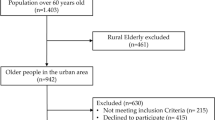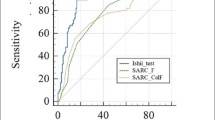Abstract
Objective
To compare the diagnostic value of the SARC-F combined with calf circumference (SARC-CalF) with the standard SARC-F to screen sarcopenia in community-dwelling older adults.
Design
Cross-sectional, diagnostic accuracy study.
Setting
Geriatric outpatient clinic of a university hospital.
Participants
Older adults >= 65 years.
Measurements
Muscle mass (bioimpedance analysis device), muscle strength (hand grip strength-Jamar hydraulic hand dynamometer), and physical performance (usual gait speed). Four currently used diagnostic criteria [European Working Group on Sarcopenia in Older People (EWGSOP), Foundation for the National Institutes of Health (FNIH), International Working Group on Sarcopenia (IWGS), and Society on Sarcopenia Cachexia and Wasting Disorders (SCWD) criteria] were applied. SARC-CalF was performed by using two different calf circumference threshold: standard cut-off 31 cm (SARC-CalF-31) and national cut-off 33 cm (SARC-CalF-33). The sensitivity/specificity analyses of the SARC-CalF and SARC-F tools were run. We used the receiver operating characteristics curves and the area under the receiver operating characteristics curves (AUC) to compare the diagnostic accuracy to identify sarcopenia.
Results
We included 207 subjects; 67 male and 140 female with a mean age of 74.6±6.7 years. The prevalence of sarcopenia ranged from 1.9% to 9.2%. The sensitivity of SARC-F was between 25% (EWGSOP) and 50% (IWGS); specificity was about 82%. For SARC-CalF-31 and SARC-CalF-33 sensitivity was in general similar - between 25-50%-which pointed out that SARC-CalF was not superior to SARC-F for sensitivity in this sample. Corresponding specificities for SARCCalF-31 and SARC-CalF-33 were higher than SARC-F and were between 90-98%. Additionally, the AUC values, which indicates the diagnostic accuracy of a screening test, were in general higher for SARC-CalF-33 than the SARC-F and SARC-CalF-31.
Conclusions
We reported that addition of calf circumference item to SARC-F tool improved the specificity and diagnostic accuracy of SARC-F but it did not improve the sensitivity in a community-dwelling Turkish older adult population sample that had low prevalence of sarcopenia. The performance of SARC-CalF tool to screen sarcopenia is to be studied in different populations and living settings.







Similar content being viewed by others
References
Cruz-Jentoft AJ, Landi F, Schneider SM, et al. Prevalence of and interventions for sarcopenia in ageing adults: A systematic review. Report of the international sarcopenia initiative (EWGSOP and IWGS). Age Ageing 2014; 43: 748–59.
Woo J, Leung J, Morley JE. Validating the SARC-F: a suitable community screening tool for sarcopenia? J Am Med Dir Assoc 2014; 15: 630–34.
Parra-Rodríguez L, Szlejf C, García-González AI et al. Cross-cultural adaptation and validation of the Spanish-language version of the SARC-F to assess sarcopenia in Mexican community-dwelling older adults. J Am Med Dir Assoc 2016; 17: 1142–1146.
Beaudart C, Locquet M, Bornheim S et al. French translation and validation of the sarcopenia screening tool SARC-F. Eur Geriatr Med 2018;9.1:29–37.
Yang M, Hu X, Xie L et al. Screening Sarcopenia in Community-Dwelling Older Adults: SARC-F vs SARC-F Combined With Calf Circumference (SARC-CalF). J Am Med Dir Assoc 2018;19:277.
Barbosa-Silva TG, Menezes AM, Bielemann RM et al. Enhancing SARC-F: Improving sarcopenia screening in the clinical practice. J Am Med Dir Assoc 2016;17:1136–141.
Bahat G., Yilmaz O., Kiliç C., Oren M.M. et al. Performance of SARC-F in regard to sarcopenia definitions, muscle mass and functional measures. J Nutr Health Aging in press
Fess EE (1992). Grip strength. In: Casanova JS(ed) Clinical assessment recommendations, American Society of Hand Therapists; 2nd edn. Chicago. pp 41–45.
Massy-Westropp NM, Gill TK, Taylor AW et al. Hand grip strength: age and gender stratified normative data in a population-based study. BMC Res Notes 2011; 14:127.
Bahat G, Tufan A, Tufan F et al. Cut-off points to identify sarcopenia according to European Working Group on Sarcopenia in Older People (EWGSOP) definition. Clin Nutr 2016; 35:1557–563.
Studenski SA, Peters KW, Alley DE et al. The FNIH sarcopenia project: Rationale, study description, conference recommendations, and final estimates. J Gerontol Ser A Biol Sci Med Sci 2014; 69: 547–58.
Malmstrom TK, Morley JE. SARC-F: A simple questionnaire to rapidly diagnose sarcopenia. J Am Med Dir Assoc 2013; 14: 531–532.
Cruz-Jentoft AJ, Baeyens JP, Bauer JM et al. Sarcopenia: European consensus on definition and diagnosis: Report of the European Working Group on Sarcopenia in Older People. Age Ageing 2010; 39: 412–23.
Fielding RA, Vellas B, Evans WJ et al. Sarcopenia: An undiagnosed condition in older adults. Current consensus definition: Prevalence, etiology, and consequences. International working group on sarcopenia. J Am Med Dir Assoc 2011; 12: 249–256.
Morley JE, Abbatecola AM, Argiles JM et al. Sarcopenia with limited mobility: an international consensus. J Am Med Dir Assoc 2011; 12:403–09.
Katz S, Ford AB, Moskowitz RW, Jackson BA et al. Studies of illness in the aged. The Index of Adl: a standardized measure of biological and psychosocial function. JAMA 1963; 185:914–9.
MP, Brody EM. Assessment of older people: self-management. Gerontologist 1969; 9:179–86.
Rabin R, de Charro F. EQ-5D: a measure of health status from the EuroQol Group. Ann Med 2001; 33:337–43.
Guigoz Y, Vellas B, Garry PJ. Assessing the nutritional status of the elderly: The Mini Nutritional Assessment as part of the geriatric evaluation. Nutr Rev 1996; 54:59–65.
Wu TY, Liaw CK, Chen FC et al. Sarcopenia screened with SARC-F questionnaire is associated with quality of life and 4-year mortality. J Am Med Dir Assoc 2016;17: 1129–135.
Malmstrom TK, Miller DK, Simonsick EM et al. SARC-F: A symptom score to predict persons with sarcopenia at risk for poor functional outcomes. J Cachexia Sarcopenia Muscle 2016;7: 28–36.
Urzi F, Šimunič B, Buzan E. Basis for Sarcopenia Screening With the SARC-CalF in Nursing Homes. J Am Med Dir Assoc 2017; 18:991.e5–991–10.
Author information
Authors and Affiliations
Corresponding author
Rights and permissions
About this article
Cite this article
Bahat, G., Oren, M.M., Yilmaz, O. et al. Comparing SARC-F with SARC-CalF to Screen Sarcopenia in Community Living Older Adults. J Nutr Health Aging 22, 1034–1038 (2018). https://doi.org/10.1007/s12603-018-1072-y
Received:
Accepted:
Published:
Issue Date:
DOI: https://doi.org/10.1007/s12603-018-1072-y




